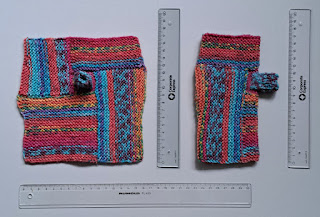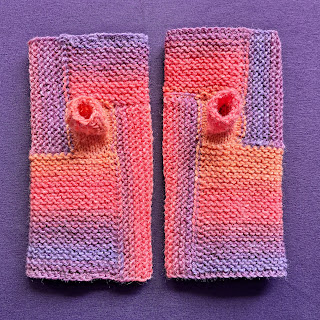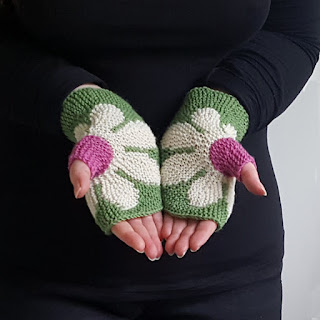I love knitting fingerless gloves. They usually are a relatively small project, but they can have quite fun and interesting constructions. These ones are designed in triangles around the thumb. The knitting direction changes often, so it is a brilliant way to display some self striping or hand-dyed sock yarn. The name "Windrädchen” is the german word for pinwheel.
Since this pattern uses quite a few knitting techniques, it is NOT A BEGINNER PATTERN.
Get a 25% discount with coupon code "WIND" - discount ends Dec 05, 2025.
The knitting pattern for these fingerless gloves is available
The pattern is 17 pages long and contains
- written row-by-row instructions for knitting this piece in one size only – including 36 in-process photos (in a separate section at the end)
- an explanation (plus schematic) of the construction,
- short photo tutorials for the following techniques
- crochet CO (a CO at the edge of a knitted piece)
- pick up and knit – with an explanation on how to pick up from a slanted edge
- picking up stitches from a gap – to avoid holes
Gauge and Size
To get a certain variation in size I knitted one pair on 3mm needles (see picture on the right, top pair of mitts) and another one pair with on 2.5 mm needles (see picture on the right, bottom pair of mitts):
- With 3 mm needles 26 ridges (53 garter stitch rows) gave me 10 cm in height and 25 sts gave 10 cm in width (with an unblocked swatch, since I didn't block the mitts). The finished piece measures 18 cm in height, with a circumference of 15 cm at the top and 16.5 cm at the bottom.
- With 2.5 mm needles 28 ridges (56 garter stitch rows) gave me 10 cm in height and 27 sts gave 10 cm in width (also with unblocked swatch). The finished piece measures 17 cm in height, with a circumference of 14 cm at the top and 15.5 cm at the bottom.
However, the pieces are all in garter stitch, so they are quite stretchy.
Materials
To knit these fingerless gloves you need the following materials
- 150 meters of fingering weight yarn weight yarn – I used
- Zwerger Opal - Schafpate 16 POTRÄÄÄH Linda - die Wasserratte (Colourway 11452) for the in process pictures
- Outstanding Silk Sock by Hooks and Yarn (in Amsterdam) for the title picture
- unlabeled solid coloured yarn for the striped pair
- 3 mm knitting needles – I used 80 cm circulars as main needles to knit the thumb
- two additional 3mm knitting needles – I used dpns to knit the panels around the thumb
- a crochet hook that is a bit bigger than the knitting needles (I used a 4 mm hook) to get a stretchy crochet CO
- a tapestry needle – for grafting and to weave in ends









































